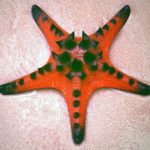Paper, A damage-tolerant, dual-scale, single-crystalline microlattice in the knobby starfish, Protoreaster nodosus.
Mechanical Engineering Assistant Professor Ling Li is studying the knobby sea star to discover the key to creating strong, lightweight materials. The sea star has a internal lattice structure which is highly organized, which is different from previous model organisms. This porous lattice structure helps make the sea star lightweight but still impact resistant. The researchers also found ossicles that connected bone to soft tissue, which allowed for flexibility in the structure. In addition, the thickening of certain regions of the skeleton and slight modifications to the lattice structure contributed to increased strength.
Learn about our two Decals!
 Click here to find out more about our Fall Bioinspired Design Decal and our Spring Bioinspired Design in Action Decal – ALL MAJORS are welcome.
Click here to find out more about our Fall Bioinspired Design Decal and our Spring Bioinspired Design in Action Decal – ALL MAJORS are welcome.Berkeley BioDesign Community
 Click here to learn about the BioD: Bio-Inspired Design @ Berkeley student organization or here to signup for more info.
Click here to learn about the BioD: Bio-Inspired Design @ Berkeley student organization or here to signup for more info.Search
Student Login




I imagine that the neurological circuits underlying these processes are governed by both 2d spacing maps with their brains as…
to reduce the impact of car accidents, it may be possible to study the force diverting physics of cockroaches to…
you see this type of head-bobbing stability in many avian creatures related to pigeons like chickens. the head ability to…
not like they taught horses how to run! this is an example of convergent evolution where both sea creatures and…
The brain functions in a similar way with neuronal connections. our brains are able to utilize the multiplicity of connections…